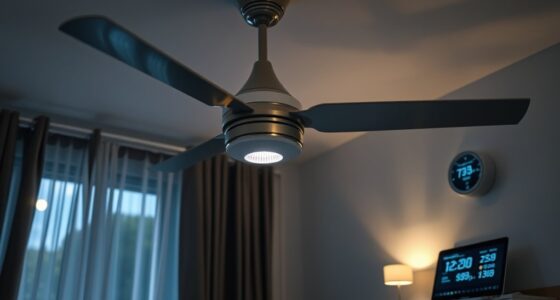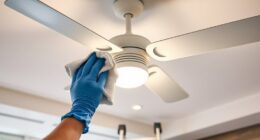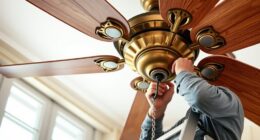Understanding a ceiling fan downrod is crucial for maximizing airflow efficiency, ensuring safe installation, and improving overall fan performance. The downrod connects the fan motor housing to mounting hardware, maintaining optimal airflow, reducing wobbling, and enhancing room aesthetics. Selecting the correct downrod length based on ceiling height is essential for efficient air circulation and preventing safety hazards. If you want to discover more about choosing the right downrod length and optimizing your ceiling fan setup, you can explore further insights into factors affecting downrod selection, standard downrod lengths, and universal compatibility recommendations.
Key Takeaways
- Downrods connect fan motor to mounting hardware.
- Proper length maintains optimal airflow and height.
- Match diameter to fan for stability and safety.
- Consider ceiling height for correct downrod selection.
- Downrods enhance fan performance and aesthetics.
Importance of Ceiling Fan Downrods
Ceiling fan downrods play a crucial role in connecting the fan's motor housing to the mounting hardware, ensuring stability and optimal airflow distribution.
When it comes to ceiling height, the downrod length becomes essential to maintain proper airflow and prevent any potential issues like wobbling.
By selecting the appropriate downrod length, you can ensure that the fan blades are at the ideal distance from the ceiling, allowing for optimal airflow circulation. This not only enhances the fan's performance but also contributes to the overall aesthetics of the room.
Proper downrod selection is key during ceiling fan installation, as it impacts both functionality and visual appeal. Ensuring that the mounting hardware is securely attached to the downrod is crucial for a safe and efficient installation process.
Functionality of Downrods

Enhancing airflow efficiency and stability, downrods serve a crucial function in connecting the fan's motor housing to the ceiling mounting hardware. The proper ceiling fan downrod length is essential for maintaining optimal airflow and ensuring the fan's blades are at the ideal height from the ceiling.
By referring to a downrod length chart and selecting the right downrod, you can improve the overall performance of your ceiling fan. Whether you have a standard or vaulted ceiling, the downrod plays a key role in keeping your fan balanced and maximizing air circulation.
Additionally, connecting the fan motor housing securely with the downrod helps reduce wobbling and noise issues, providing a smoother and more enjoyable fan experience. Understanding the functionality of downrods is crucial for achieving the best results from your ceiling fan setup.
Choosing the Right Downrod Length
To ensure optimal airflow efficiency and stability, selecting the correct downrod length is key when setting up your ceiling fan. Proper positioning of the fan at the right height from the ceiling is essential for optimal performance. Accurate measurements of the ceiling height and fan are crucial for choosing the right downrod length. For a standard 8-9 foot ceiling, a downrod length ranging from 3-6 inches is recommended. However, for a 12-foot ceiling, a longer 3-foot downrod would be more suitable for maintaining the fan at the ideal height. Hunter fans, in particular, have specific downrod requirements based on the model to ensure they operate efficiently. By calculating the difference between the ceiling height and the fan height, you can determine the appropriate downrod length for your installation.
| Ceiling Height | Recommended Downrod Length |
|---|---|
| 8-9 feet | 3-6 inches |
| 12 feet | 3 feet |
Matching Downrod Diameter to Fan

Selecting the appropriate downrod diameter is essential for ensuring the stability and safety of your ceiling fan installation. When matching the downrod diameter to your fan, consider the following:
- Check Manufacturer Recommendations: Always refer to the manufacturer's guidelines to determine the recommended downrod diameter for your specific ceiling fan model.
- Ensure Stability: Choosing the correct downrod diameter helps in stabilizing the fan and prevents wobbling or imbalance issues, enhancing safety during operation.
- Support and Functionality: A well-matched downrod diameter provides adequate support for the fan, ensuring optimal functionality and performance.
- Enhanced Installation: Proper downrod diameter selection simplifies the installation process, promoting a secure and reliable setup for your ceiling fan.
Factors Affecting Downrod Selection
Considering the factors impacting downrod selection is crucial for ensuring the proper installation and functionality of your ceiling fan. When determining the appropriate downrod length, factors such as ceiling height, fan height, and desired hanging height play a significant role.
Additionally, the pitch of the ceiling can affect the selection process, as angled ceilings may require special mechanisms for secure mounting. It's essential to choose a downrod that's compatible with your specific ceiling fan model to guarantee both safety and efficiency.
Seeking guidance from professionals can be beneficial, especially when dealing with unique spaces or angled ceilings that may pose challenges during installation. By taking into account these factors and ensuring compatibility, you can optimize the performance and safety of your ceiling fan while also enhancing the overall aesthetic of your space.
Optimal Ceiling Height for Downrods

When it comes to ceiling fan downrods, the optimal ceiling height is crucial for efficiency. Ideal downrod length and recommended ceiling clearance play essential roles in ensuring proper airflow.
Maintaining the right height is key to maximizing your ceiling fan's performance.
Ideal Downrod Length
Why is the ideal downrod length crucial for ceiling fan efficiency at different ceiling heights? Proper placement of the fan with the right downrod length ensures optimal airflow and efficient air circulation.
To achieve this, consider the following:
- Ceiling Height: Ensure the downrod length matches the height of your ceiling for effective performance.
- Fan Blades to Floor Distance: The downrod helps in maintaining the ideal distance between the fan blades and the floor.
- Optimal Airflow: Choosing the suitable downrod length ensures that the fan operates efficiently to circulate air effectively.
- Suitable Downrod Length: Downrods ranging from 3-6 inches are typically recommended for ceilings at the ideal height of 8-9 feet.
Recommended Ceiling Clearance
To ensure optimal performance of your ceiling fan, it's essential to consider the recommended ceiling clearance for installing the appropriate downrod length. The ideal height for ceiling fan installation is between 8-9 feet from the floor. This placement allows for proper airflow distribution and circulation in the room, ensuring maximum efficiency.
If your ceiling is higher than 9 feet, using a downrod can help adjust the fan to the correct height. Hunter recommends a 3-6 inch downrod for ceilings within the standard 8-9 feet range to maintain proper airflow and energy efficiency.
Standard Downrod Lengths

Standard downrod lengths for ceiling fans typically range from 2 to 72 inches, catering to various ceiling heights and room sizes. When choosing the right downrod length, it's essential to consider the optimal airflow and stability of the fan in different room sizes.
Here are some key points to understand about standard downrod lengths:
- For an 8-9 feet ceiling, a recommended downrod length falls between 3-6 inches to ensure proper fan placement and airflow efficiency.
- Higher ceilings may require longer downrods to maintain stability and achieve the ideal fan position.
- Manufacturers offer varying downrod lengths, with some providing options that extend up to 177 inches for customization.
- The selection of the correct downrod length plays a crucial role in maximizing the airflow performance of the ceiling fan while also ensuring its stability in the designated room size.
Calculating Downrod Length

When determining the appropriate downrod length for a ceiling fan, it is crucial to calculate the recommended measurement by subtracting the ceiling height from 9. This calculation ensures proper positioning of the fan for efficient airflow. For instance, a 12-foot ceiling would typically require a 3-foot downrod to maintain the ideal distance between the fan blades and the ceiling. Different Hunter fan models may have specific downrod length requirements to optimize performance. Accurate measurements are essential during fan installation to guarantee the correct downrod length is selected.
To help you understand better, here's a table showcasing the recommended downrod lengths based on ceiling heights:
| Ceiling Height | Recommended Downrod Length |
|---|---|
| 8 feet | 1 foot |
| 9 feet | 2 feet |
| 10 feet | 3 feet |
| 11 feet | 4 feet |
| 12 feet | 3 feet |
Selecting the right downrod length is key to ensuring your ceiling fan operates effectively and efficiently.
Universal Downrod Compatibility

Selecting compatible downrods for your ceiling fan is essential to ensure proper installation and safety. When considering universal downrod compatibility, here are some key points to keep in mind:
- Manufacturer's Recommendation: Always purchase the right ceiling fan downrod recommended by the manufacturer to ensure compatibility and proper airflow.
- Outdoor Ceiling Fans: For outdoor ceiling fans, make sure to choose a downrod specifically designed for outdoor use to withstand different weather conditions.
- Size and Diameter: Verify the length and diameter of the downrod to guarantee it fits your ceiling height and fan model correctly.
- Purchase Considerations: When purchasing a downrod, consider factors like the threaded vs. non-threaded design and the finish to ensure a secure and aesthetically pleasing installation.
Downrod Color and Finish Options

I prefer downrod color and finish options that enhance the overall aesthetic of my ceiling fan. When choosing the right color and finish for your downrod, consider how it will complement or contrast with your ceiling fan to achieve the desired look. Options like brushed nickel, bronze, and matte black provide versatility to match various decor styles. The materials used in downrods, such as steel, aluminum, and wood, not only impact durability but also influence the appearance of the downrod. Additionally, decorative sleeves can be added to customize the look further.
| Color Options | Finish Options | Materials |
|---|---|---|
| Brushed Nickel | Sleek and modern | Steel, Aluminum |
| Bronze | Classic and elegant | Steel, Aluminum |
| Matte Black | Bold and contemporary | Steel, Wood |
Frequently Asked Questions
How Do You Choose the Right Ceiling Fan Downrod Length?
When choosing the right ceiling fan downrod length, consider installation tips, design aesthetics, room size, blade clearance, downrod material, ceiling height, downrod color, and energy efficiency.
For optimal performance, subtract the ceiling height from 9 to calculate the ideal downrod length. Accurate measurements are essential. Different ceiling heights may require specific downrod lengths.
Hunter fans have unique downrod requirements. Choose the appropriate length for proper fan positioning and efficiency.
Does Downrod Length Affect Airflow?
Yes, downrod length significantly impacts airflow efficiency in a room.
Longer downrods are crucial for optimal performance, especially in rooms with high ceilings.
The correct downrod size ensures proper blade clearance and consistent air circulation.
Choosing the right length is key for efficient airflow, proper installation, and maximizing motor performance while reducing energy consumption.
It all adds up to a comfortable and aesthetically pleasing environment.
How Far Down Should My Ceiling Fan Hang?
To ensure optimal performance and safety, my ceiling fan should hang 8-9 feet above the floor. Using a downrod can help achieve this ideal height. Popular brands offer various downrod lengths to accommodate different ceiling heights.
Proper installation tips are essential for energy efficiency and safety. Remote control options, blade materials, and light fixture compatibility should also be considered.
Outdoor use restrictions must be followed for safety reasons.
Do I Need a Downrod for a 10 Foot Ceiling?
Yes, a 10-foot ceiling typically requires a downrod for optimal fan height and performance. It ensures proper airflow distribution and stability, preventing wobbling. Different downrod lengths may be needed based on the fan model.
Consult manufacturer guidelines or a professional for installation advice. Downrods enhance energy efficiency and safety by maintaining the right distance between blades and floor. Consider design options and compatibility issues for the best results. DIY alternatives are available but caution is advised.
Can I Use a Downrod on Any Type of Ceiling Fan?
Yes, you can use a downrod for installing a fan on any type of ceiling fan. It helps to lower the fan and improve airflow in rooms with high or vaulted ceilings. Just make sure to choose the correct size and style of downrod to ensure proper installation and function of your fan.
Conclusion
After understanding all the ins and outs of a ceiling fan downrod, you'll be ready to tackle any fan installation with ease.
Just remember, the key to success is to always choose the right length and diameter for optimal performance.
And who knew a simple rod could make such a big difference in your home's comfort and style?
Happy fan hanging!









